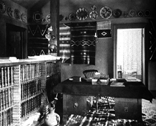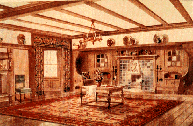David actively studies and is meticulous in correctly representing the Art and Crafts furniture movement.
A brief history on the Arts and Crafts movement
The Arts and Crafts movement initially developed in England during the latter half of the 19th century. Subsequently this style was taken up by American designers, with somewhat different results. In the United States, the Arts and Crafts style was also known as Mission style.
This movement, which challenged the tastes of the Victorian era, was inspired by the social reform concerns of thinkers such as Walter Crane and John Ruskin, together with the ideals of reformer and designer, William Morris.
Their notions of good design were linked to their notions of a good society. This was a vision of a society in which the worker was not brutalized by the working conditions found in factories, but rather could take pride in his craftsmanship and skill. The rise of a consumer class coincided with the rise of manufactured consumer goods. In this period, manufactured goods were often poor in design and quality. Ruskin, Morris, and others proposed that it would be better for all if individual craftsmanship could be revived– the worker could then produce beautiful objects that exhibited the result of fine craftsmanship, as opposed to the shoddy products of mass production. Thus the goal was to create design that was… ” for the people and by the people, and a source of pleasure to the maker and the user.” Workers could produce beautiful objects that would enhance the lives of ordinary people, and at the same time provide decent employment for the craftsman.
Medieval Guilds provided a model for the ideal craft production system. Aesthetic ideas were also borrowed from Medieval European and Islamic sources. Japanese ideas were also incorporated early Arts and Crafts forms. The forms of Arts and Crafts style were typically rectilinear and angular, with stylized decorative motifs reminiscent of medieval and Islamic design. In addition to William Morris, Charles Voysey was another important innovator in this style. One designer of this period, Owen Jones, published a book entitled The Grammar of Ornament, which was a sourcebook of historic decorative design elements, largely taken from medieval and Islamic sources. This work in turn inspired the use of such historic sources by other designers.
However,in time the English Arts and Crafts movement came to stress craftsmanship at the expense of mass market pricing. The result was exquisitely made and decorated pieces that could only be afforded by the very wealthy. Thus the idea of art for the people was lost, and only relatively few craftsman could be employed making these fine pieces.
However in the United States, the Arts and Crafts ideal of design for the masses was more fully realized, though at the expense of the fine individualized craftsmanship typical of the English style. In New York, Gustav Stickley was trying to serve a burgeoning market of middle class consumers who wanted affordable, decent looking furniture. By using factory methods to produce basic components, and utilizing craftsmen to finish and assemble, he was able to produce sturdy, serviceable furniture which was sold in vast quantities, and still survives. The rectilinear, simpler American Arts and Crafts forms came to dominate American architecture, interiors, and furnishings in the late nineteenth and early twentieth century.
Today Stickley’s furniture is prized by collectors, and the Stickley Company still exists, producing reproductions of the original Stickley designs.
The term Mission style was also used to describe Arts and Crafts Furniture and design in the United States. The use of this term reflects the influence of traditional furnishings and interiors from the American Southwest, which had many features in common with the earlier British Arts and Crafts forms. Charles and Henry Greene were important Mission style architects working in California. Southwestern style also incorporated Hispanic elements associated with the early Mission and Spanish architecture, and Native American design. The result was a blending of the arts and crafts rectilinear forms with traditional Spanish colonial architecture and furnishings. Mission Style interiors were often embellished with Native American patterns, or actual Southwestern Native American artifacts such as rugs, pottery, and baskets. The collecting of Southwestern artifacts became very popular in the first quarter of the twentieth century.





